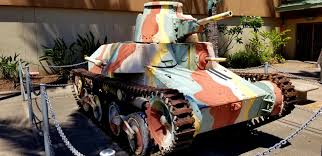THE DO’S AND DON’TS OF AMERICAN FLAG ETIQUETTE

Japanese Type 95 Ha-Go Light Tank on display outside the U.S. Army Museum of Hawaii, Fort DeRussy, Waikiki.
Intrigued to learn more about this tank, I reached out to the museum shortly after I got back home. The U.S. Army Museum of Hawaii was quick to reply, and although the info about the tank’s history was limited, they were very obliging in helping with my request. The following is what they were able to provide.
“Captured by Company A, 193rd Tank BN, 27th Inf. Div. Nov 1943 on Makin Island. Our records indicate that this tank came to us by way of transfer from 69th Armor, elements of which were assigned to the 25th Infantry Division in February 1957. 69th Armor’s affiliation with the 25th Infantry Division ended for the final time when it was inactivated and relieved of assignment to the 25th Infantry Division in June 1972. Date of transfer for the tank is reflected as 7 Dec 1976 which is the same year the museum at Fort DeRussy opened”.
Aside from confirming the tank to be a captured veteran of WWII, the above info didn’t seem like a lot but after doing a simple Google search, that little bit of information resulted in page after page of search results. I’ll do my best to correctly summarize some of those results without writing a novel but it might not be easy.
Makin Atoll (Island) is part of the Gilbert chain of islands which are sometimes are
considered a southern continuation of the Marshall Islands. Anyone who has some knowledge about the war in the Pacific will likely recognize the names Marshall and Gilbert and will also think of the Battle of Tarawa. The Japanese occupied the Gilbert Islands three days after the attack on Pearl Harbor. They placed troops on many of the islands and with regards to Makin, a seaplane base was built to help monitor Allied forces in the South Pacific.
In early 1943, as part of a greater strategy to defeat Japan, the U.S. began making plans to occupy the Marshall Islands via the Gilberts. Those plans included the taking of Makin Island. From November 20th to 23rd, U.S. forces that included the 27th Infantry Division and its supporting units like Company A of the 193rd Tank Battalion attacked Makin. It was during this action that the museum’s Japanese tank was captured. Battle accounts tell of two tanks that were part of an antitank barricade or bunker. They were abandoned and never brought into action by the Japanese. During the attack, one of the tanks was damaged while the other remained intact. Pictured below is one of those two tanks and although the left track is damaged, the rest of the tank appears to be reasonably intact and could possibly be the one on display at the museum.
From the internet, the Type 95 Ha-Go was a replacement for the Type 89 Medium Tank that was produced in 1931. By 1933, the Type 89 was already considered as too slow for mechanized warfare and needed to be replaced. Prototypes of the 95 Ha-Go were built by Mitsubishi and production started in 1936 with 2,300 tanks completed by the end of
WWII. It was armed with a 37 mm main gun and two 7.7 mm (0.303 inch) machine guns. The Type 95 weighed 7.4 tons and had three crewmen. It was powered by a six cylinder, 110 h.p., air cooled diesel engine with a range of 90 to 100 miles at speeds of up to 30 m.p.h. In 1939, the Type 95 Ha-Go Light Tank battled against the Soviet Red Army then afterwards against British and U.S. Forces throughout the Pacific Theater during World War II. On December 22, 1941, the Type 95 light tank earned the distinction of being the first tank to engage in tank vs. tank combat against U.S. manned American M3 Stuart Light Tanks in the Philippines during World War II and hence the only enemy tanks to have ever landed on “North American” soil during any war.
This is an excerpt taken from an article written by a recent visitor, Terry Witiuk for CMP Magazine Issue #81, April 2020.
Become a supporter today of the U.S. Army Museum of Hawaii, by purchasing a souvenir Ha-Go Shirt. All donations support the maintenance and upkeep of the our artifacts and exhibits.
We look forward to seeing you soon!
